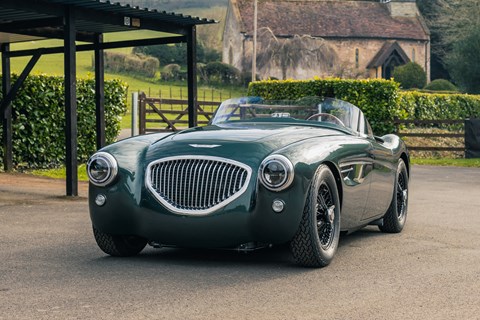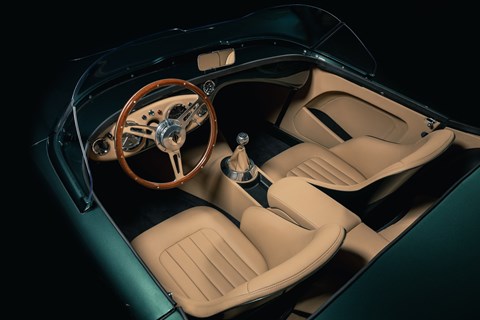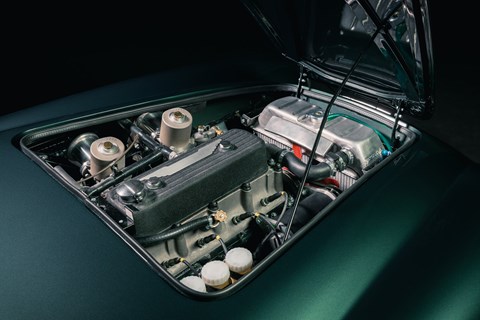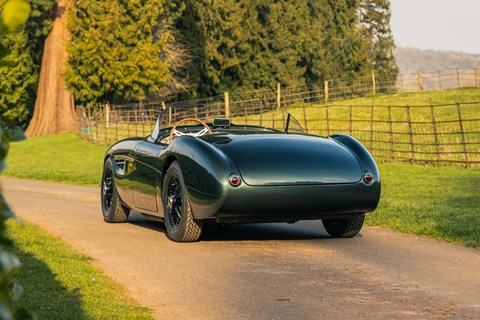► Subtle styling tweaks inside and out
► Rebuilt 3.0-litre four-cylinder engine
► Production limited to 25 examples
Restomods are big business at the minute, with modern driver assistance technology creating a rich market for cars offering that yesteryear motoring experience. Companies like Singer and David Brown Automotive have done a lot to carve out the niche, specialising in modernising icons like the classic Porsche 911 and the original Mini.
Now though, there’s a new kid on the block. Start-up Coventry coachbuilder Caton has launched a reimagined version of the 1953 Austin-Healey 100, which features updated styling, a modernised interior and a host of mechanical upgrades that promises to keep the car competitive with today’s traffic.

Caton plans to build just 25 examples of its reimagined Healey 100 – and all of them will be hand-assembled by a team of engineers in its Coventry headquarters. As an interesting side-note, Caton’s main shed is located just 10 miles north of the workshop in which the first Healey 100 prototype was born in 1952.
Come on, then. What’s changed?
Quite a lot, actually – most of which will have the Austin-Healey 100 owners club screaming heresy. The front end has been completely redesigned, with a new front grille, fresh aluminium quarter panels and a lower front valance that hides the car’s front chassis legs.
The front and rear bumpers have also been binned, while the original halogen headlamps have been swapped for a swanky set of LED units. This latter change is probably for the best, because the old headlights were about as useful as candles in jam jars.

Caton has made a few subtle changes to the Healey 100’s design. For example the car’s original external boot hinges have been swapped for new internal hinges with gas struts, while the boot lid itself gets a modern electric release that’s operated by the key fob.
The interior has received the same treatment, with new leather upholstery, a pair of USB charging ports and new door cards that have pockets large enough to store water bottles. Caton also moved the seat mounts back and fitted a new AP racing pedal box to allow taller drivers to get comfortable behind the wheel.
Anoraks won’t be pleased at all. Will the engine irritate them too?
Well, that all depends on how progressive your anorak is. Liberal anoraks could probably learn to live with it, as the 3.0-litre four-cylinder petrol engine shares the same block as an original Healey 100. It’s even carbureted, which scores a couple more brownie points.
However, if you’re anywhere near a die-hard anorak, leave the explanation at that because everything inside the engine (that’s the crank, pistons, camshaft and roller rockers) is new. All of the tolerances have been tightened and the compression ratio has been bumped up significantly, doubling the engine’s output from 90bhp to 185bhp.

The Healey’s standard three-speed gearbox would have been reduced to a casing full of shrapnel with that much grunt passing through it, so Caton has fitted a new five-speed unit. Just to add insult to the anorak’s injury, the car’s original column shift lever has also been swapped for a new stick poking out of the transmission tunnel.
What about the chassis? Big changes there, as well?
Caton gave the Healey’s underside a thorough going-over, fitting new adjustable coil spring suspension up front and rose-jointed anti-roll bars all round. However, the rear end features an updated version of the car’s original leaf-spring setup.
Like an untouched Healey 100, the steering system remains unassisted – although the brakes have been improved. Buyers get AP racing discs all round with four-pot callipers up front and three-pot callipers at the rear. You don’t get ABS or traction control, though.
Caton’s changes are rounded off by a set of 72-spoke knock-on alloy wheels wrapped in period-correct but modern manufactured Michelin tyres. Production is set to start in Spring 2022, and the car’s public debut is scheduled for 21st April at Salon Prive London.
